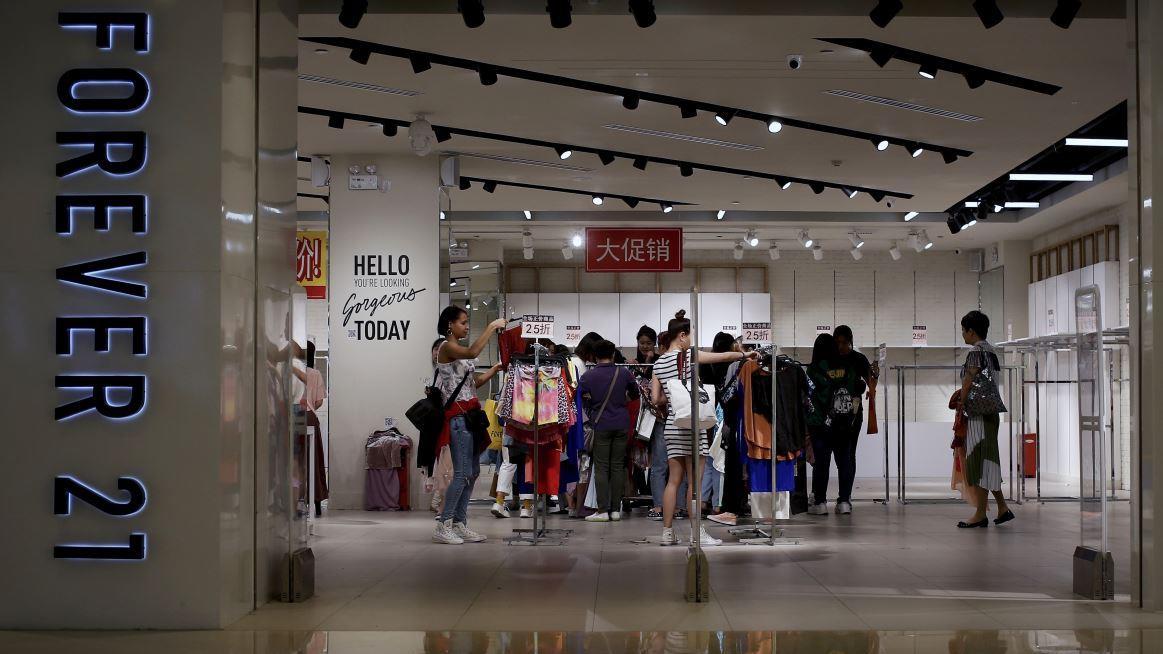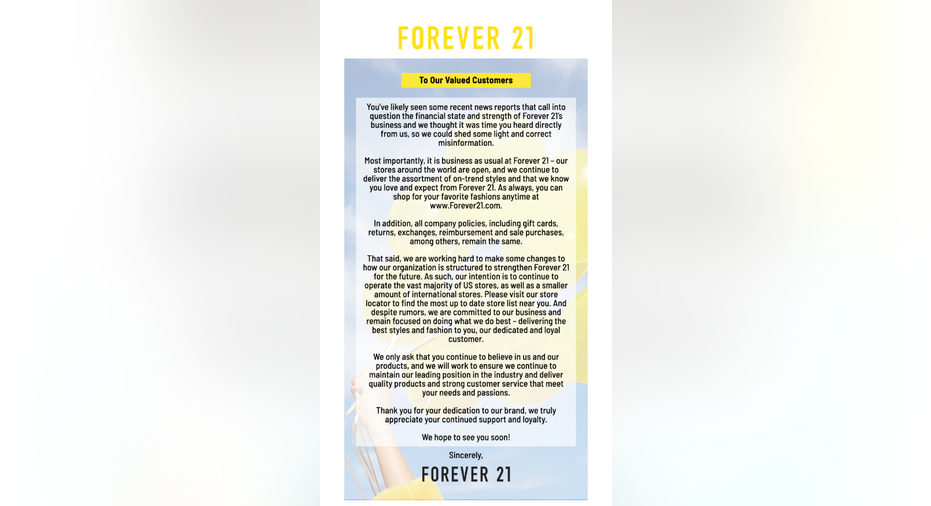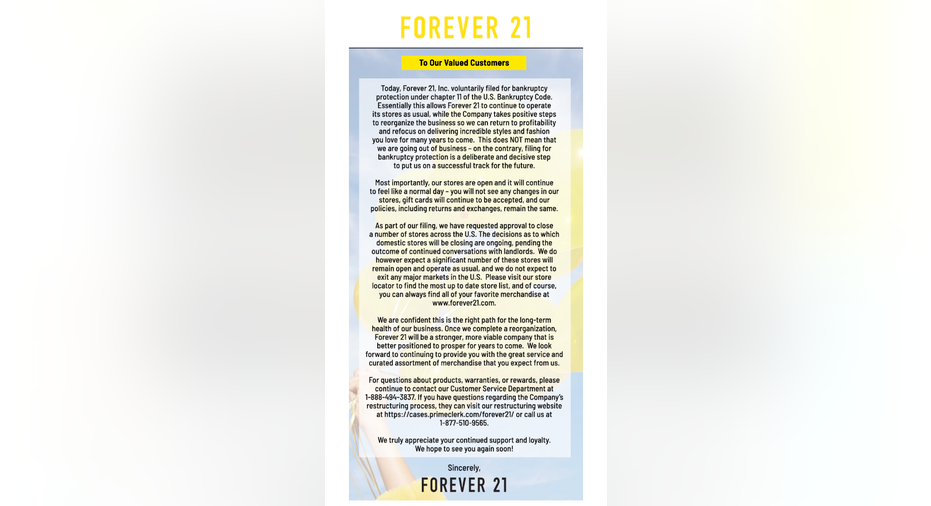Forever 21 bankruptcy: 5 reasons why it may have happened
Forever 21 is about to start aging.
The iconic youth-focused fashion retailer announced to its customers on Monday that it indeed is filing for bankruptcy despite its attempts to quash rumors about the business development in a newsletter 10 days prior. Under the U.S. Bankruptcy Code’s chapter 11, Forever 21 will remain open while it “takes positive steps to reorganize the business.”
Up to 178 stores will close throughout the U.S.—which is sure to hurt thousands of employees who rely on the retailer for a source of income. Operations are also said to halt in 40 countries.
Forever 21 sent out a newsletter to customers on Sept. 20, telling them not to believe the "misinformed" bankruptcy rumors. (Forever 21)
For some devoted shoppers, the announcement comes as a shock. However, a number of brick and mortar stores have struggled to keep money flowing with the rise of ecommerce juggernauts like Amazon providing the convenience of speedy shipping.
Fashion outlets that have shuttered a part of their business or have gone out of business completely include other notable mall staples like Payless, Kohl’s, Dressbarn, Topshop, Ralph Lauren, Lord & Taylor and more.
Forever 21, which was founded by Korean-born American husband and wife Do Won and Jin Sook Chang in 1981, grew to amass a network of over 800 stores while becoming multi-billion dollar company. Despite this, the trendy fashion chain that covertly imprints bible verses regarding everlasting life on its shopping bags, couldn’t be spared from what some have dubbed the “retail apocalypse.”
Here are five reasons that may have contributed to Forever 21’s downfall.
1. Rapid expansion
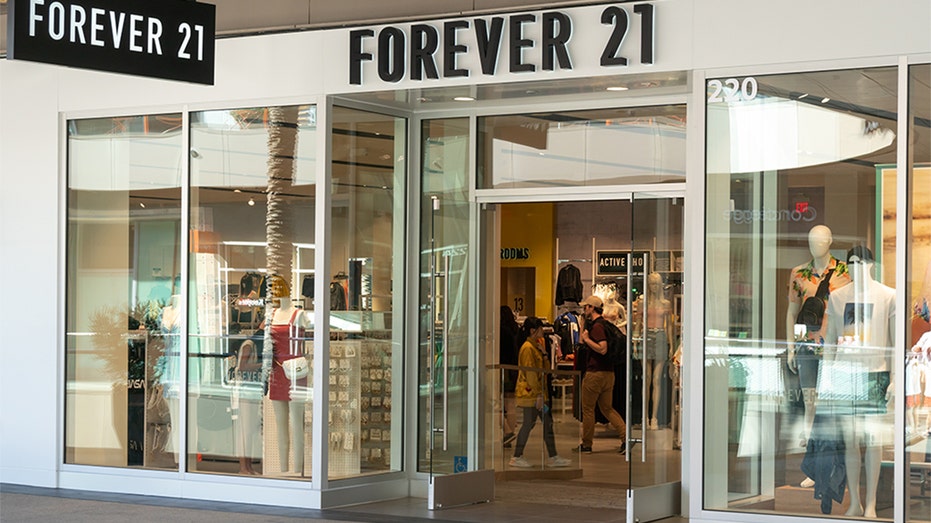
SANTA MONICA, CA/USA - APRIL 18, 2019: Forever 21 retail store exterior and trademark logo.
In Forever 21’s “About Us” section of their website, it acknowledged that it was the fifth largest specialty retailer in the U.S. and was aiming to “become an $8 billion company by 2017 and open 600 stores in the next three years.” However, just like with any other business that aggressively expands, there is sure to be a whole lot of debt that comes with it.
The company also revealed that the average size of a Forever 21 store is 38,000 square feet while the largest is 162,000 square feet. A market study that observed the average rent paid by square foot in the U.S. for industrial space found that businesses classified under “special purpose” paid $6.50 per square foot. If that figure holds true for today’s standards, a 38,000-square-foot Forever 21 would cost about $247,000 for rent alone. Similarly, a 162,000-square-foot location would cost an astounding $1,053,000.
2. Bad publicity
According to a report by the social media analysis website Sprout Social, nine out of ten customers will stop purchasing from brands that lack transparency. These findings are a detriment to Forever 21 since the company has been embroiled in back-to-back lawsuits for trademark and copyright infringement for years.
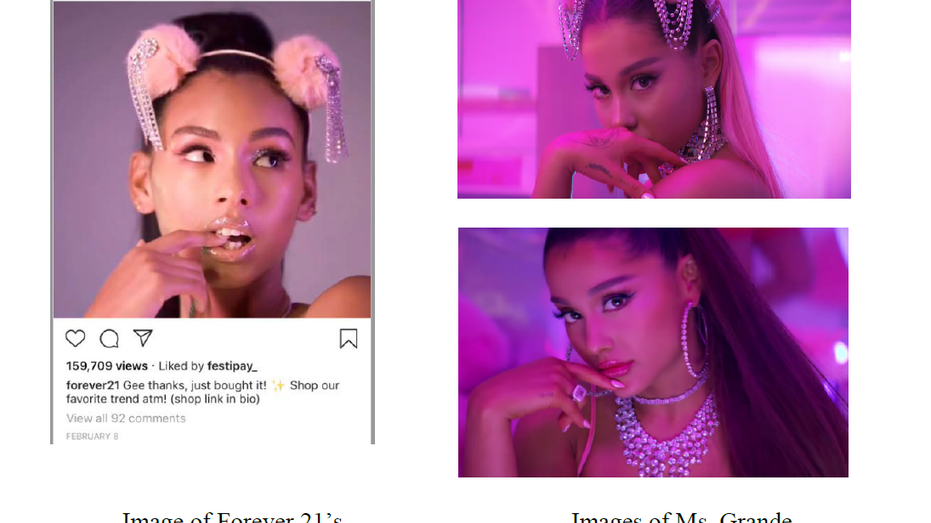
Photo shows example of Forever 21's unauthorized use of Ariana Grande's brand, September 3, 2019. (source: lawsuit)
Whether from big household name designers to small indie brands, Forever 21 has made a knockoff version for customer purchase. Gucci, Adidas and Puma are just a few big dogs that have attempted a courtroom battle with Forever 21. Pop singer Ariana Grande has filed a $10 million lawsuit of her own over the value brand “stealing her” image and likeness.
3. Fast fashion and the competition
Forever 21 might be known for their quick-turning duplications, but they are not alone in the fast fashion world. Competitors such as H&M and Zara have vied for the same consumer base that wants trendy clothing at an affordable or low-cost price point. Popular London-based ecommerce brands like ASOS and Pretty Little Thing have also taken a swipe at profits with their lucrative celebrity collaborations.
The Instagram famous Los Angeles-based brand Fashion Nova has also given Forever 21 a run for its money with shameless knockoff business strategy that churns out replicated designs in less than 24 hours.
4. Shifting consumers
Conversely, there is a buying base that opposes everything fast fashion stands for. These shoppers are generally concerned for the environment, whether it be through minimizing fabric waste or not supporting an industry that has brought on harsh working conditions. This desire for sustainable fair trade has allowed the secondhand clothing market to grow to an estimated $28 billion worldwide, according to a consumer survey from analytics aggregator Statista.
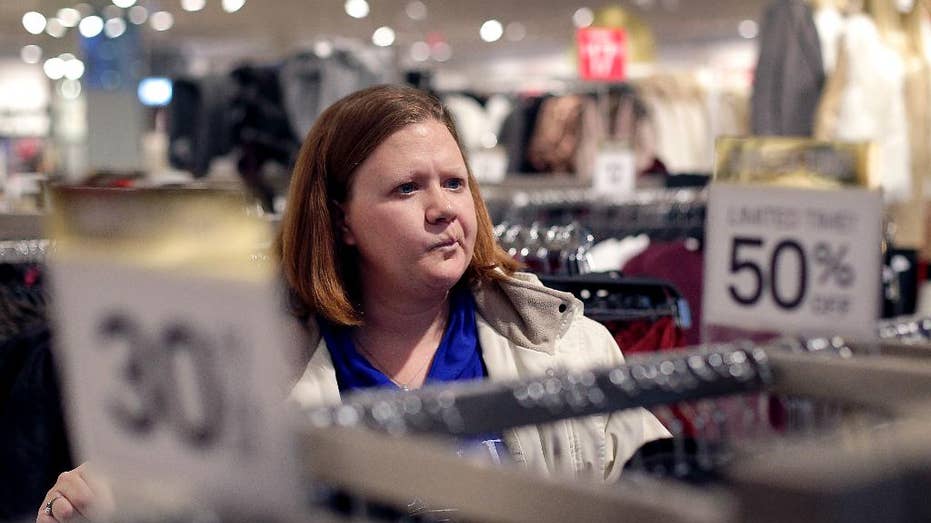
FILE - In this Saturday, Nov. 28, 2015, file photo, Janae Melvin shops for gifts at Forever 21 in Kansas City, Kan. (AP Photo/Charlie Riedel, File)
The call for body positivity in the fashion industry has also impacted Forever 21 despite the store having a dedicated plus size and curvy sections in U.S. stores. Outside the small pickings these departments have, Forever 21 highlights its ultra-thin models more frequently—which may have alienated its full-figured base that is said to have a buying power of about $46.4 billion according to business management consultants at Coresight Research.
Forever 21’s shipping of free diet bars over the summer also didn’t help the brand’s image.
CLICK HERE TO READ MORE ON FOX BUSINESS
5. Unfocused inventory
Although majority of Forever 21 stores offer various selections, the brand appears to have extended its reach too far. With its other lines like XXI Forever, For Love 21 and Heritage 1981, the retail store has carried a mixed bag of styles that are both overwhelming and in conflict with shoppers’ inner Marie Kondo call for minimalism.

A mall storefront of Forever 21's beauty-focused sister store Riley Rose. (Riley Rose)
The store has also dabbled in creating a home décor, tech accessory and cosmetics line that is cheap in price but lacking in durability. Forever 21’s sister brand, Riley Rose, which sells third-party beauty products never took off the way the company hoped. Even top beauty retailer Ulta is struggling with a shifting market that prizes skincare over makeup.
GET FOX BUSINESS ON THE GO BY CLICKING HERE
A January report in Business of Fashion said Forever 21 had its sights on doubling the number of Riley Rose stores. That doesn’t appear to be happening while the business reorganizes its strategy under bankruptcy.




















